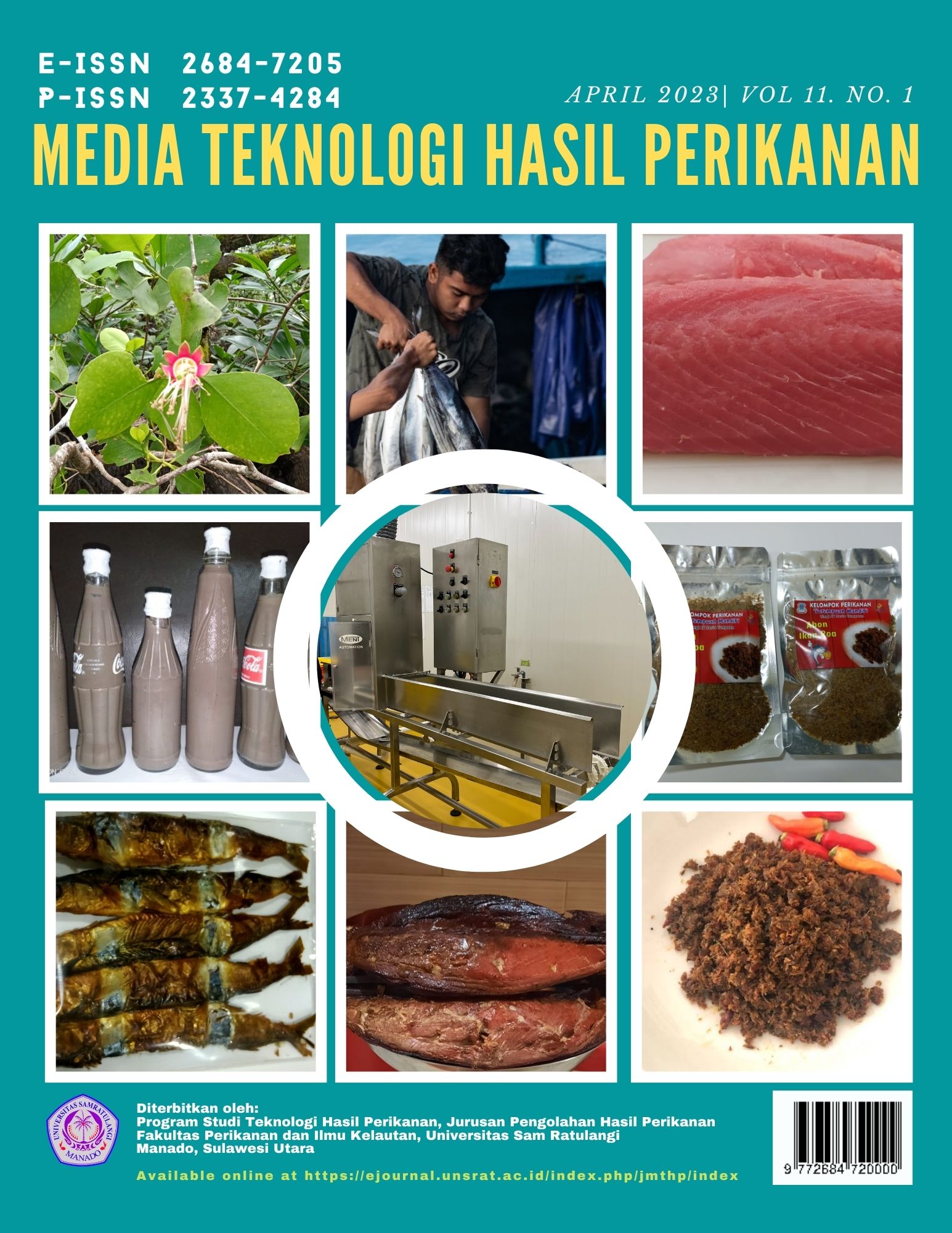Kajian Mutu Produk Tuna Steak Beku Di PT. Anping Seafood Indonesia
DOI:
https://doi.org/10.35800/mthp.11.1.2023.36152Abstract
Histamine content is used as an indicator of tuna freshness, this study aims to analyze the quality of fresh tuna (Thunnus albacares) raw materials and the quality after becoming the final product of frozen tuna steak at PT. Anping Seafood Indonesia by calculating histamine levels and organoleptic tests. The method that will be used in this research is descriptive analysis. The organoleptic test results data from the responses of 6 panelists to the raw materials of fresh tuna were all very fresh and met the SNI 01-2346-2015 standard. The data of organoleptic test results on frozen tuna steak products in the first production, second production in the third production sample obtained nothing that exceeded the SNI standard limit. The organoleptic value of frozen tuna steak products meets the organoleptic quality requirements. Histamine levels of fresh tuna raw materials and histamine levels of frozen tuna steak products obtained from the three productions met the quality and food safety requirements (SNI 01-4485.1-2006).
Keywords: Fresh Tuna, Loin, Steak, Histamine, Organoleptic
References
DAFTAR PUSTAKA
Laismina, A. N., Montolalu, L. A., & Mentang, F. (2014). KAJIAN MUTU IKAN TUNA (Thunnus Albacares) SEGAR DI PASAR BERSEHATI KELURAHAN CALACA MANADO. MEDIA TEKNOLOGI HASIL PERIKANAN, Vol. 2, No. 2.
Lombu, F. V., Agustin, A. T., & Pandey, E. V. (2015, Agustus). PEMBERIAN KONSENTRASI ASAM ASETAT PADA MUTU GELATIN KULIT IKAN TUNA. Media Teknologi Hasil Perikanan, Vol.3, No.2.
Maulana , H., Afrianto , E., & Rustikawati, I. (2012). Analisis bahaya dan penentuan titik kritis pada penanganan tuna segar utuh di PT. Bali Ocean Anugrah Linger Indonesia Benoa Bali. Jurnal Perikanan dan Kelautan, 3(4), 1-5.
Nurani, T. W., Murdaniel, R. P., & Harahap, M. H. (2013). UPAYA PENANGANAN MUTU IKAN TUNA SEGAR HASIL TANGKAPAN. Marine Fisheries, Vol. 4, No. 2(ISSN 2087-4235), 153-162.
Putra, D., Dien, H. A., Montolalu, R. I., Makapedua, D. M., Onibala, H., Sumilat, D. A., & Luasunaung, A. (2020, September). Efek Suhu dan Waktu Simpan terhadap Kualitas Bagian Tengah Tuna Sirip Kuning Segar (Thunnus albacares). Media Teknologi Hasil Perikanan, 8(3), 100-106.
Resnia, R., Wicaksena, B., & Salim, Z. (2015). KESESUAIAN SNI DENGAN STANDAR INTERNASIONAL DAN STANDAR. Kesesuaian SNI dengan Standar Internasional dan Standar Mitra Dagang, 87-98.
Sabrina, A. D., Wurani, T. W., & Wahyuningrum, P. I. (2019). Prosiding Seminar Perikanan Tangkap ke-8 “Arah Pembangunan Perikanan Tangkap Masa Depan: Pendekatan Transdisiplin. (Dr Ir Darmawan, MAMA, & Prof Dr Ir Tri Wiji Nurani, MSi, Eds.) Departemen Pemanfaatan Sumberdaya Perikanan Fakultas Perikanan dan Ilmu Kelautan IPB.
Santoso, A., Palupi, N., & Kusumaningrum, H. D. (2020, 7 20). PENGENDALIAN HISTAMIN PADA RANTAI PROSES PRODUK IKAN TUNA BEKU EKSPOR. MAJALAH ILMIAH STANDARDISASI, 131-142.
Setyaningsih, D., Apriantono, A., & Puspita, M. (2010). Analisis Sensori untuk Industri Pangan dan Agro. Bogor: IPB Press.
Downloads
Published
How to Cite
Issue
Section
License
Copyright (c) 2023 Media Teknologi Hasil Perikanan

This work is licensed under a Creative Commons Attribution-ShareAlike 4.0 International License.
Authors who publish with this journal agree to the following terms:
- Authors retain copyright and grant the journal right of first publication with the work simultaneously licensed under a Creative Commons Attribution License that allows others to share the work with an acknowledgement of the work's authorship and initial publication in this journal.
- Authors are able to enter into separate, additional contractual arrangements for the non-exclusive distribution of the journal's published version of the work (e.g., post it to an institutional repository or publish it in a book), with an acknowledgement of its initial publication in this journal.
- Authors are permitted and encouraged to post their work online (e.g., in institutional repositories or on their website) prior to and during the submission process, as it can lead to productive exchanges, as well as earlier and greater citation of published work (See The Effect of Open Access).







